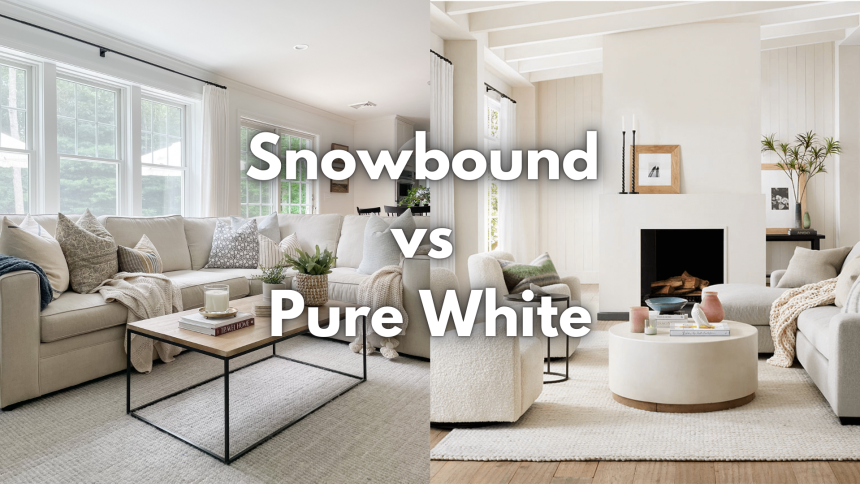Ever stood in the paint aisle, staring at two white paint chips that look identical? You’re not alone.
White walls bring light into our homes, but choosing between similar shades can be tricky. Snowbound and Pure White are two popular options that often leave homeowners scratching their heads.
I spent three months testing both colors in different rooms of my house. The results might surprise you.
In this guide, I will walk you through the real differences between snowbound vs pure white – from how they look in morning light to how they pair with wood tones.
By the end, you’ll know exactly which white is right for your space.
Let’s get into the details that matter.
Snowbound (SW 7004)
Snowbound is a soft, warm white with subtle gray and pink undertones. This combination gives it a cozy and inviting feel, making it suitable for various interior settings.
Its warmth and subtle undertones make Snowbound ideal for living rooms, bedrooms, and hallways.
It’s also a popular choice for trim and cabinetry, providing a soft contrast to walls.
Pros and Cons:
Pros: Creates a warm and welcoming atmosphere; versatile in various lighting conditions; pairs well with natural wood tones and other warm colors.
Cons: The pinkish undertones might not suit all design preferences; may appear slightly darker in rooms with limited natural light.
Pure White (SW 7005)
Pure White is a clean, bright white with the slightest hint of warmth. It has subtle yellow undertones that prevent it from appearing too stark, offering a fresh and airy feel.
Due to its neutrality, Pure White works well in various settings, including kitchens, bathrooms, and offices.
It’s also a popular choice for trim, ceilings, and cabinetry, providing a crisp look without being overly bright.
Pros and Cons:
Pros: Offers a fresh and clean appearance; highly versatile, complementing both warm and cool tones; maintains color consistency across different lighting conditions.
Cons: May appear slightly yellow in certain lighting; lacks the warmth some might desire in specific settings.
Key Differences Between Snowbound and Pure White
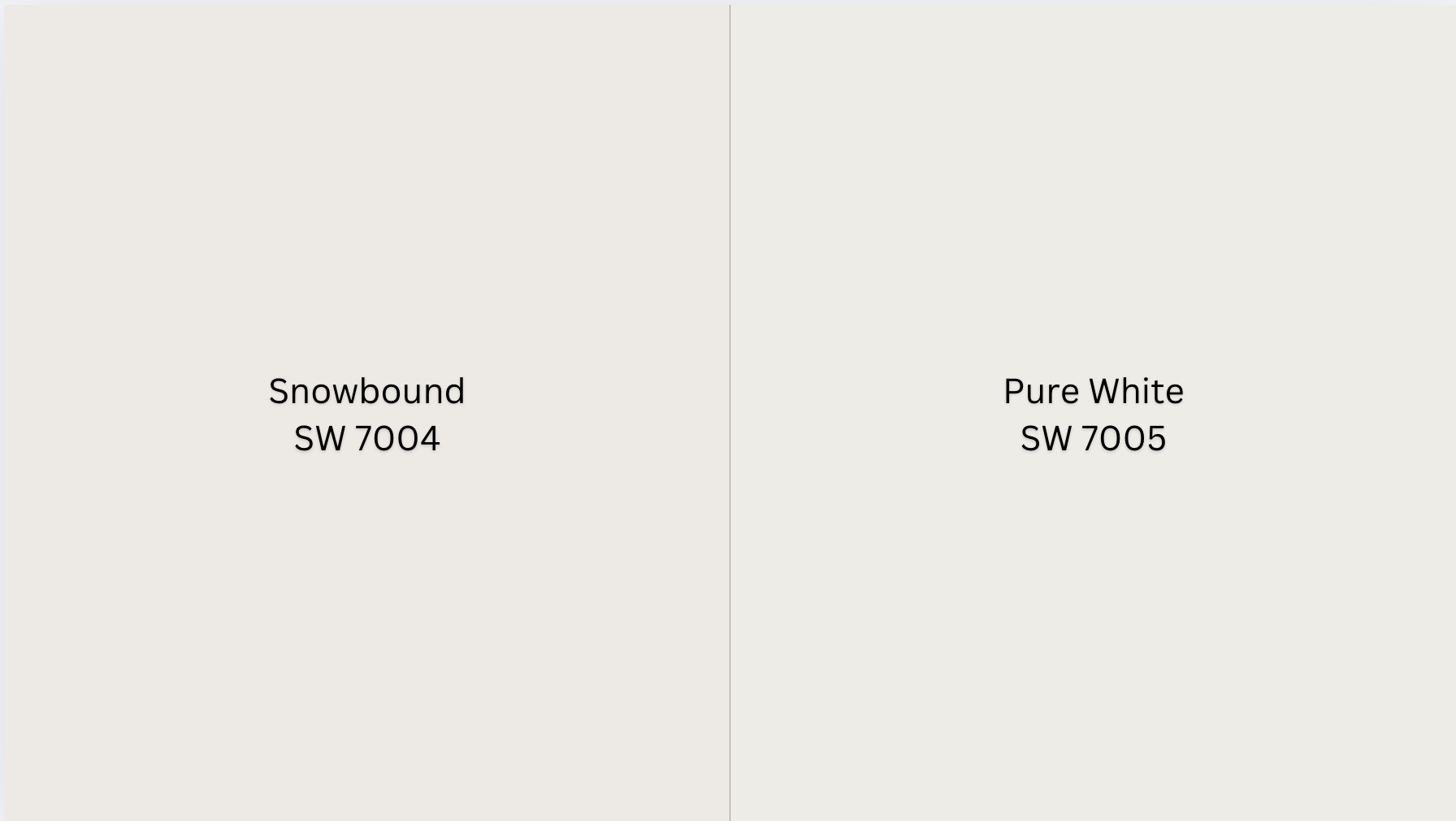
To gain a deeper understanding of how Snowbound and Pure White compare, it’s important to look at their unique characteristics.
While both colors are versatile and offer a clean, bright appearance, they each bring something distinct to a space.
Let’s take a closer look at the key differences between these two shades in terms of their light reflectance value (LRV), color category, and other factors that can influence their performance in various rooms.
| Aspect | Snowbound (SW 7004) | Pure White (SW 7005) |
|---|---|---|
| LRV | 83 | 84 |
| Color Category | Light color (LRV ≈ 83) | Light color (LRV ≈ 84) |
| RGB Value | Red: 237, Green: 234, Blue: 229 | Red: 237, Green: 236, Blue: 230 |
| Hex Code | #EDEAE5 | #EDECE6 |
| Undertones | Soft, warm undertones with hints of gray and pink | Slight yellow undertones, providing a warm and inviting feel |
| Best Pairings | Soft whites, darker greiges, warm browns | Crisp whites, warm beiges, muted blues |
| Ideal for | Cozy, balanced, urbane interiors | Bright, airy, modern spaces |
Note: LRV (Light Reflectance Value) measures the percentage of light a color reflects; higher values indicate lighter colors.
Room-by-Room Comparison with Image
Now that we’ve discussed the key differences between Snowbound and Pure White, let’s get into a room-by-room comparison to see how each color performs in different settings.
Please note- On the left, you’ll see Pure White, while the right image showcases Snowbound applied.
Bedroom

Pure White: Offers a crisp, fresh look with subtle warmth, creating a bright and inviting atmosphere. It reflects a significant amount of light, enhancing the room’s brightness.
Snowbound: Provides a soft, cozy ambiance with its gray-pink undertones, ideal for a relaxing retreat. It reflects a substantial amount of light, contributing to a warm and inviting space.
Living Room
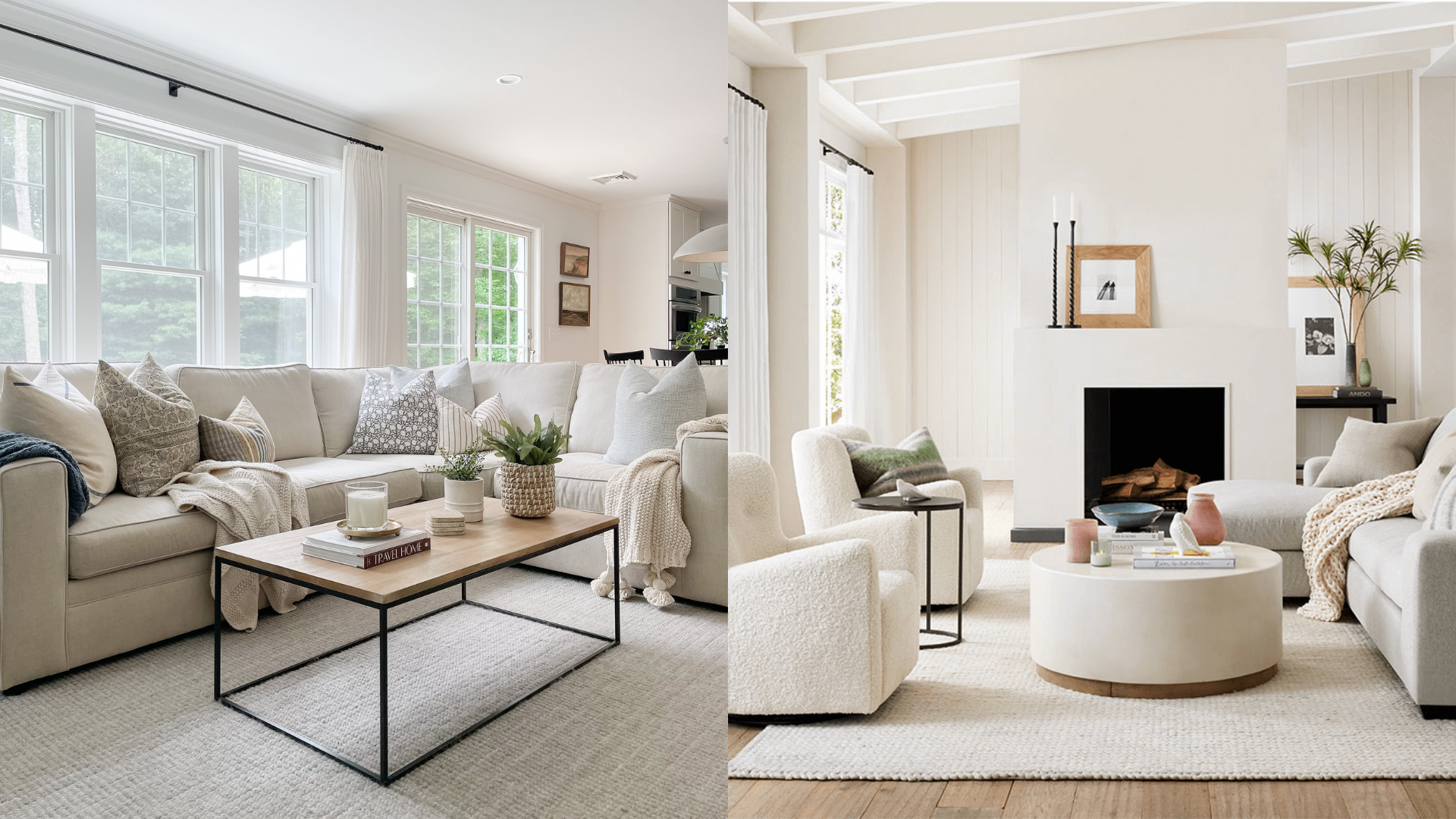
Pure White: Its neutral tone complements various decor styles, making the space feel open and airy. The slightly higher LRV ensures the room remains bright and welcoming.
Snowbound: Adds warmth and depth, enhancing a welcoming and comfortable environment. It maintains a light-filled yet cozy atmosphere.
Kitchen
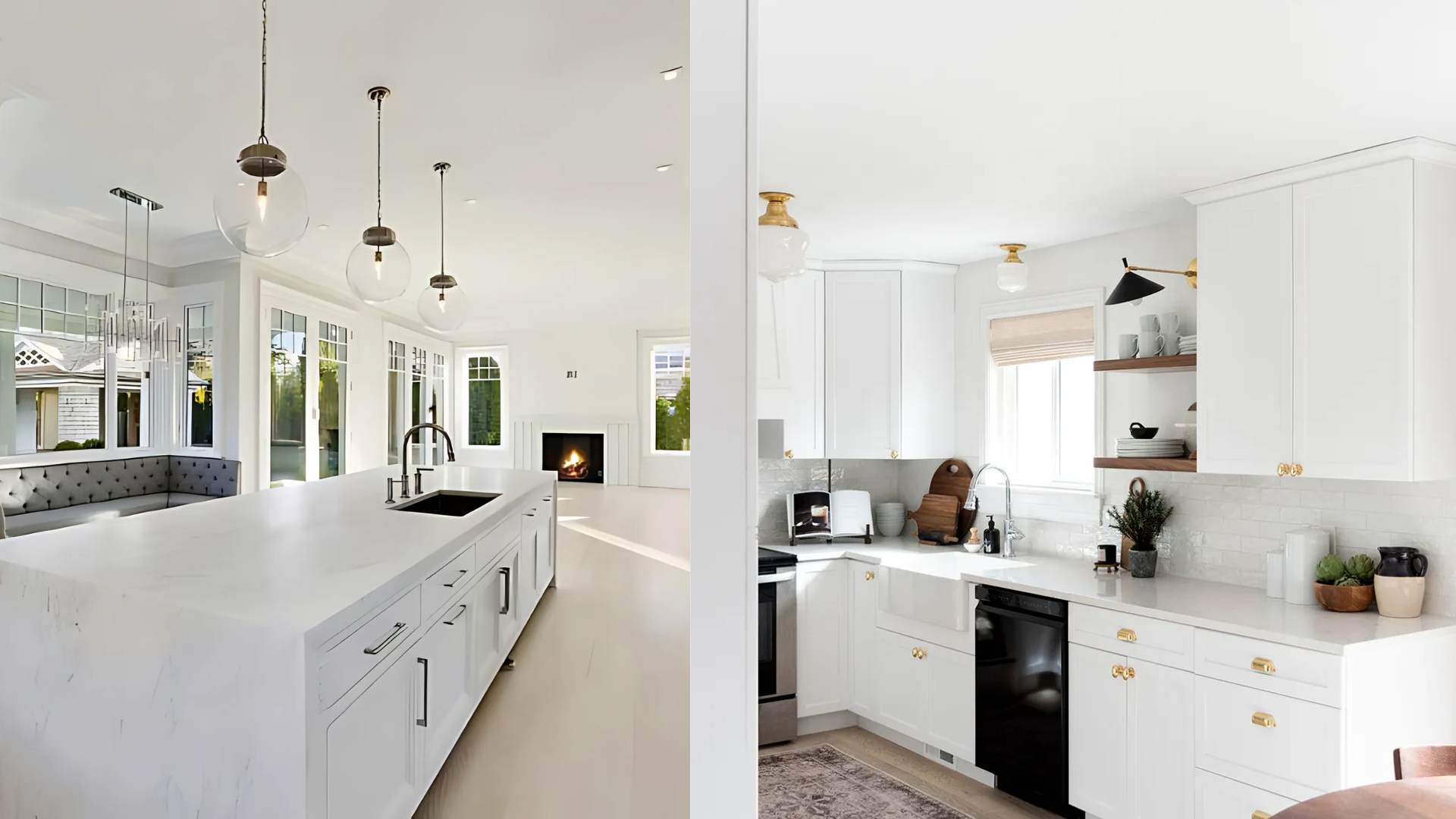
Pure White: Maintains a clean, bright appearance, pairing well with both warm and cool tones. It reflects ample light, keeping the kitchen vibrant.
Snowbound: Its subtle warmth complements natural materials like wood, creating a cozy cooking space. This ensures the kitchen feels inviting without being overly bright.
Bathroom
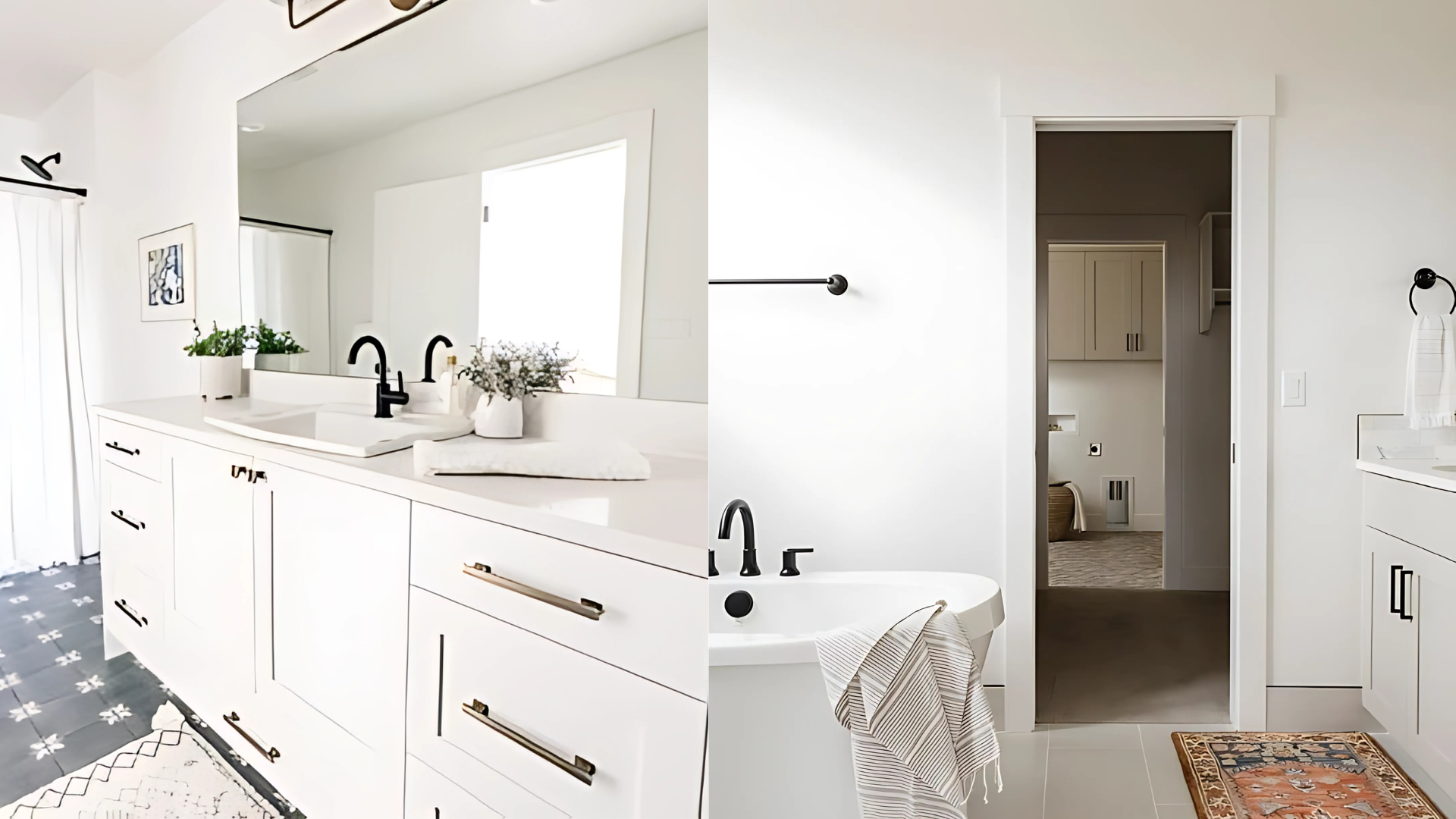
Pure White: Resists yellowing, keeping the space feeling fresh and clean over time. It contributes to a bright and airy bathroom.
Snowbound: Shines in bathrooms, offering a fresh, crisp look that complements various fixtures. It provides a clean appearance while maintaining warmth.
In summary, Pure White offers a bright, warm appearance suitable for various settings, while Snowbound provides a cool, serene atmosphere, particularly fitting for modern designs.
How to Choose the Best Option?
When deciding between Sherwin Williams’ Snowbound (SW 7004) and Pure White (SW 7005), it’s important to consider how each color will interact with your space’s lighting, ambiance, and existing design elements.
Choose Snowbound (SW 7004) if you prefer a cool, modern space with subtle gray undertones, especially in spaces with ample natural light. It’s ideal for contemporary designs and works well with cool-toned decor.
Snowbound’s slightly lower LRV of 83 also gives it a slightly more muted look, making it ideal for contemporary spaces that require a bit of depth and sophistication.
On the other hand, Opt for Pure White (SW 7005) if you’re seeking a warm, versatile white that complements various decor styles and lighting conditions.
Its slight yellow undertones provide warmth, making it suitable for traditional and transitional spaces. Pure White offers a brighter and more neutral tone, with an LRV of 84.
Pure White’s ability to adapt to both warm and cool-toned decor makes it incredibly versatile and a top choice for variety of applications, from trim and walls to ceilings.
Can We Use Both of Them Together?
Snowbound (SW 7004) and Pure White (SW 7005) are both versatile whites from Sherwin Williams, each bringing unique qualities to a space.
Both colors have similar Light Reflectance Values (LRV) , when used together, they can complement each other effectively, enhancing various design elements.
Additionally, Snowbound’s cool undertones may appear more pronounced in dimly lit rooms, whereas Pure White maintains a consistent, neutral presence, making them both adaptable to various lighting conditions.
Practical Applications
Bathrooms and Kitchens
In spaces like bathrooms and kitchens, Snowbound can be used on walls to create a fresh, clean backdrop, while Pure White can be applied to trim, cabinetry, or wainscoting to add brightness and contrast.
Living and Dining Areas
Using Snowbound on walls and Pure White on ceilings or as an accent can add dimension and interest to living and dining areas, creating a balanced and inviting environment.
Advice: Before finalizing your choice, always take a patch test by applying small samples of both colors on your walls. This will allow you to see how each color looks in different lighting conditions throughout the day and with your existing furniture, helping you make the best decision for your space.
In Closing: Making Your Choice
Picking the right white paint isn’t just about trends or what others suggest. It’s about what works in your space and makes you happy.
Take your time with this decision. Put up sample patches on different walls. Look at them in morning light, afternoon sun, and with lamps on at night.
The perfect white creates a backdrop for your life – family gatherings, quiet evenings, busy mornings. It sets the mood for countless moments in your home. Trust the process of finding your ideal shade. There’s no rush, and no wrong answer. Your home should feel like you.
Remember that paint is one of the most budget-friendly ways to change your space. If you try one and change your mind later, it’s okay. Your walls, your rules.
Happy painting!

